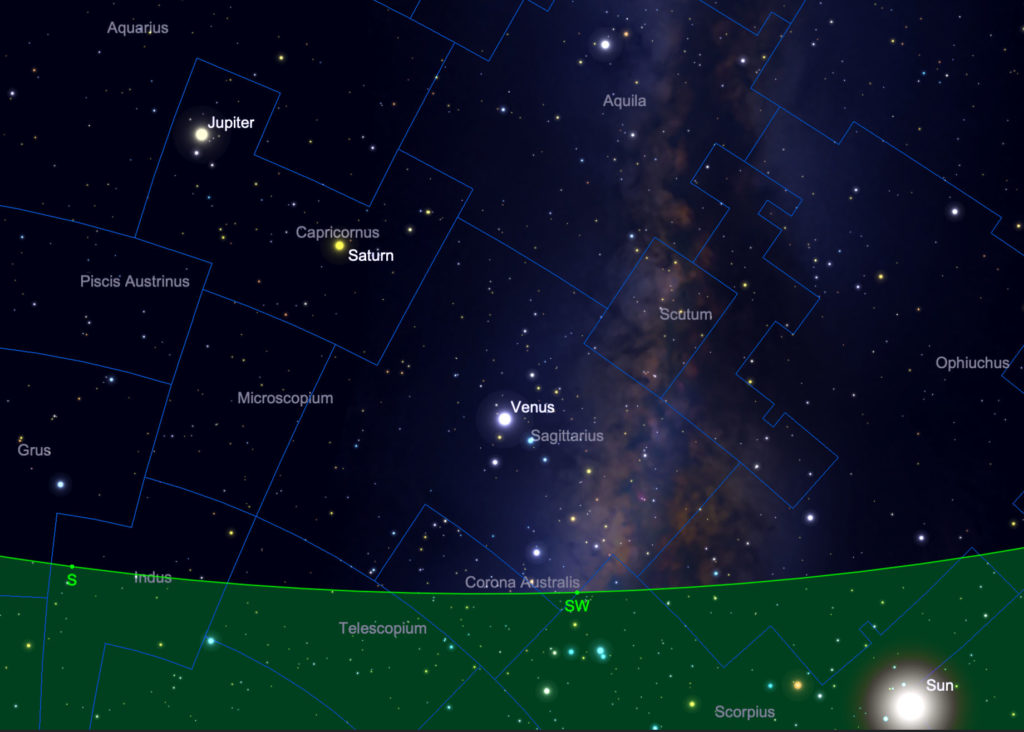Sky Report: November 22 – November 28

The planets 1 hour after sunset on the 23rd, plus stars and constellation boundaries above and below the translucent horizon. Venus is moving toward Jupiter and Saturn; by your own observations when will Saturn be exactly mid-way between them? Graphic created with SkySafariAstronomy.com.
The bright planets Venus, Jupiter, and Saturn are nearly equally spaced in the southwest in the evening sky, with Saturn slightly closer to Jupiter than to Venus. Venus’ motion around the sun is carrying it eastward against the background stars of Sagittarius and closer to the outer planets, which, being slower in their orbits, are barely moving against the distant stars. Watch carefully, and by your own observations on which night is Saturn exactly between Jupiter and Saturn? The planets’ motions are a continuous process, not a series of isolated events.
These three bright planets have graced the early evening sky and we are used to seeing them there, so enjoy them now. But in only a month Jupiter and Saturn will be low in the west, setting early, and Venus will be gone, and beginning in February the evening sky will be entirely devoid of bright planets. Don’t take their appearance for granted.
Because the earth moves 1° a day eastward as we orbit the sun (360° in 365-1/4 days), the distant planets Jupiter and Saturn move 1° a day westward. So do the stars behind them; this is the consequence of the earth’s annual motion around the sun. Moving 1° westward means they set 4 minutes earlier each day, or a half-hour earlier each week, or two hours earlier each month. Where the planets are at 7:00 tonight is where they will be at 6:00 in two weeks.
This general guideline applies to the outer planets and stars near the ecliptic – the path of the planets — but not to Mercury and Venus. Their individual motions also must be taken into account. This week alone, for example, Venus’ angular distance from sun decreases from 44° to 42°, causing it to set even earlier than the above formula would suggest. You’ll see that dramatically in mid-December when Venus rapidly disappears from the evening sky.
Mars is very slowly returning to view in the morning sky where it is not very bright. Look for it very low in the east-southeast during morning twilight. It’s especially close to the star Zubenelgenubi on the morning of the 22nd when the star is only 1/5° above Mars. Zubenelgenubi is 1/3 as bright as Mars and it has a companion star traveling with it, so the two make a beautiful pair in binoculars; three including Mars.
Under a grant from the Utah Governor’s Office of Economic Development and the Kane County Office of Tourism, Stellar Vista Observatory offers portable telescopes and tripod mounted binocular kits on loan for free to all residents of Kane County. Nothing beats a quality binocular or astronomical telescope to enhance enjoyment of the night sky! Visit https://stellarvistaobservatory.org/discover-the-night-sky/ or Kanab City Library for full details.
The Sky Report is presented as a public service by the Stellar Vista Observatory, a nonprofit organization based in Kanab, Utah, which provides opportunities for people to observe, appreciate, and comprehend our starry night sky. Additional information is at www.stellarvistaobservatory.org. Send questions and comments to John@StargazingAdventures.org.






Comments are closed.